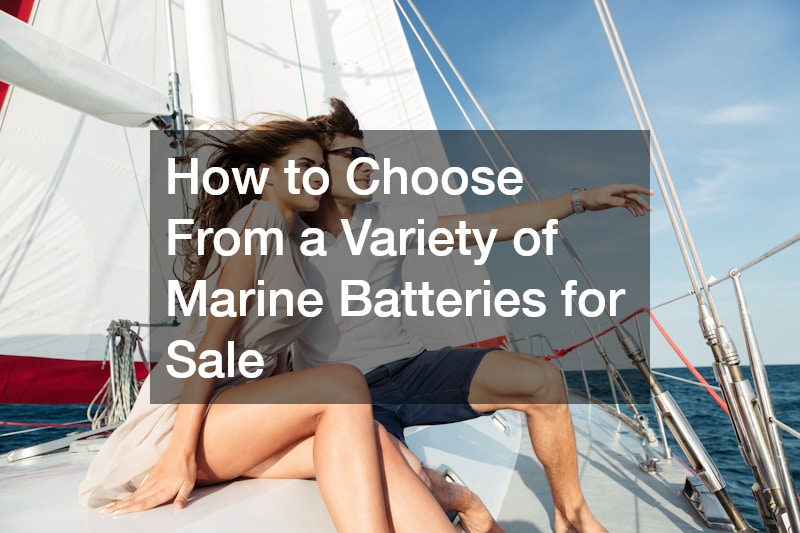When examining the styles of marine batteries for sale, it’s important to be able to comprehend their differences. With various options available, understanding the key factors is essential for making an informed decision. The decisions you make about your marine battery can directly affect your boating experience, performance, and safety on the water.
Choosing the right battery is particularly important given the different requirements for various types of vessels and activities — from leisurely afternoons on a sailboat to high-energy fishing expeditions. A well-chosen marine battery not only powers your boat’s engine but also keeps essential systems such as navigation and communication running smoothly. Therefore, before you make a purchase, it is crucial to educate yourself on the options available.
Understand Battery Types
Marine batteries are generally categorized into three main types: starting batteries, deep cycle batteries, and dual-purpose batteries. Each type serves a unique purpose and is designed for specific functions on a boat. Starting batteries deliver a large amount of current for a short time to start the engine, while deep-cycle batteries provide a steady amount of power over a longer duration.
Understanding the differences can save you from potential frustrations on the water. For instance, if you primarily use your boat for short trips, a starting battery might suffice. However, for longer excursions or for powering accessories such as lights and pumps, a deep-cycle battery is more appropriate.
Dual-purpose batteries combine the strengths of both starting and deep cycle batteries, making them a versatile choice for boaters who need a reliable solution for varied power demands. When making your selection, consider how you plan to use your boat and the power needs you anticipate.
Determine Battery Size
Choosing the correct size battery involves considering your boat’s power requirements and space constraints. Start by assessing the electrical demands of your vessel, including the engine, electronics, and any additional accessories you may use. Knowing how much amp-hour rating you will need can help you choose a battery with sufficient capacity.
It’s essential to calculate your total watt-hours to ensure that your battery can meet the demands of your equipment. Remember that different battery types come with varying capacities and dimensions, so it’s equally important to take physical space into account where the battery will be housed on your boat.
In addition, always consider the weight of the battery and how it impacts your boat’s overall balance and performance. Ensuring your vessel remains well-balanced can contribute to safer navigation and better fuel efficiency during your outings.
Examine Battery Specifications
Manufacturers provide various specifications that can influence performance, such as cold cranking amps (CCA), reserve capacity (RC), and amp-hour ratings. CCA measures the battery’s ability to start an engine in cold conditions, making it a crucial factor for those who boat in colder climates. The reserve capacity indicates how long the battery can sustain a load without dropping below a specified voltage.
Amp-hour ratings are vital for determining how long your battery can supply a given amount of current before needing a recharge. For example, if you have a device that draws 10 amps and your battery has a rating of 100 amp-hours, it will last for about 10 hours. Understanding these specifications ensures that the battery you choose can handle your boating needs efficiently.
Additionally, it’s also wise to look for other specifications such as dimensions, weight, and construction materials, as they can affect installation, longevity, and overall compatibility with your boat. Taking the time to scrutinize these details can result in a better performance and lifespan of your marine battery.
Choose Safe and Reliable Options
Safety is paramount when it comes to batteries. Regularly checking your battery for any signs of wear and tear is essential to ensure it remains safe for use. Maintenance includes keeping terminals clean and secure, checking the electrolyte levels in lead-acid batteries, and ensuring that connections are tight to avoid arcing or corrosion.
Understanding the importance of proper installation cannot be overstated. It’s crucial to follow manufacturer guidelines for mounting and wiring the battery to prevent short circuits and other dangers. Using the correct gauge wiring and protective fuses can safeguard your electrical systems and maintain a reliable power flow.
Moreover, always store batteries in a location that protects them from extreme temperatures or undue stress. Overheating can compromise battery integrity, while freezing temperatures can diminish performance. A well-cared-for battery can offer optimal reliability and a longer lifespan, giving you peace of mind during outings.
Selecting the right marine battery involves understanding the types, sizes, specifications, and safety measures. By following this guide, you can make an informed choice that meets your boating needs. Ultimately, the right marine battery not only enhances your experience on the water but is also a vital element in ensuring your vessel’s safety and efficiency.
Investing your time in learning about marine batteries can pay off significantly in terms of performance and reliability. Whether you’re setting sail for a day of fishing or navigating through challenging waters, the right battery makes a world of difference. So, equip yourself with knowledge and venture confidently into the vast marine world, where every electrical decision can lead to memorable experiences on the water.



